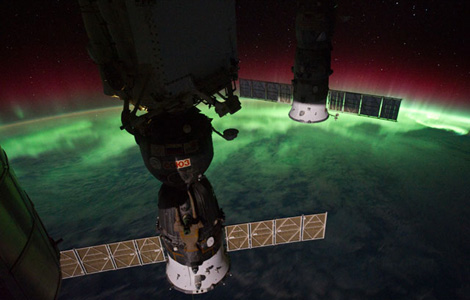Space 2012: What’s Ahead
Twelve things to watch for in space next year—if the world doesn’t end
/https://tf-cmsv2-smithsonianmag-media.s3.amazonaws.com/filer/89/ed/89ed5ee7-4e99-431d-a190-61ba9ffdd832/1024px-astronaut-eva.jpg)
Predicting the future is never easy, things don’t always turn out the way you expect, blah blah blah….
Here goes anyway, with our forecast of space program events and trends for the coming year:
1. Russification of space. Human spaceflight will feel a little more Russian now that the space shuttle’s retired and all astronauts and cosmonauts are launching on the Soyuz. On any given day, half the International Space Station crew is Russian, with the three remaining slots shared by the other international partners. While this causes angst in some quarters, the situation is temporary, and has occurred before—notably in the 1970s, between Apollo-Soyuz and the first shuttle launch, when the only spaceflights were to Salyut stations. As for NASA’s current reliance on the Soyuz, perhaps we should no longer care, 50 years into the Space Age, who’s launching whom to Earth orbit. There’s a whole Solar System to explore—does it matter who drives the taxi to the airport?
2. Showtime for SpaceShipTwo… If Virgin Galactic hopes to begin suborbital passenger trips in 2013, as NASA, for one, is expecting, look for them to wrap up their test program and start announcing firm launch dates sometime in the next year. XCOR’s one-passenger Lynx spaceplane is also supposed to begin flight tests in 2012. Who knows what Blue Origin is up to? They don’t disclose much, other than “We’re already working on our next development vehicle.”
3. …and for SpaceX. For Elon Musk, the revolution begins now. On February 7, SpaceX’s Falcon 9 rocket will launch a Dragon capsule to execute the first commercial spacecraft docking to the International Space Station. If that and the other Falcon launches planned for 2012 are successful, will the doubters start to consider SpaceX an established launch company? Orbital Sciences’ Cygnus cargo vehicle, which doesn’t get as much attention, is also scheduled to make its debut next year.
4. Curiosity drops in on Mars. The Mars Science Laboratory’s landing on August 5 will be exciting, and a little hair-raising; project scientists will be nervously peeking through their hands in those last few moments before touchdown. If it works, they can look forward to the most ambitious Mars mission ever. As for what’s next in Mars exploration….that’s a dilemma. The sample return mission proposed by a recent National Academy of Sciences panel to set planetary exploration priorities is so complex and expensive that NASA may not be able to afford it.
5. NASA bloat and drift. Republican presidential hopeful Mitt Romney drew laughs at a recent candidates’ debate with the mere mention of lunar colonies. Not a good sign for those advocating a NASA return to the moon. An election year in a down economy is hardly the best time to push for a grand new space project. Still, there are ways to start small, with a robots-first approach. And NASA is mulling other near-term goals, like sending astronauts to a nearby asteroid (a report on likely destinations for human spaceflight is due to Congress in mid-year).
But unless the agency finds some clever way to do more with less, most of its money and attention will go to a few large, expensive projects: running the space station, finishing the James Webb Space Telescope, and building the large, Congressionally mandated rocket known as the Space Launch System. Meanwhile, legislators cut in half NASA’s $1 billion request for space technology—the cool, experimental stuff—which makes innovation unlikely.
6. Occupy Tiangong. China’s space program is about where the U.S. and Russian programs were in the mid-1960s, but it’s progressing rapidly and methodically, and has the attention of top politicians. Look for Chinese astronauts launched on Shenzhou spacecraft—perhaps even the country’s first woman space traveler—to board (temporarily) the Tiangong 1 proto-space station sometime in 2012.
7. One giant leap for robotkind. Actually, two leaps. A robotic refueling test using the space station’s two-armed Dextre robot is scheduled 2012, after years of planning by some of the same people who once hoped to demonstrate robotic rescue of the Hubble Space Telescope. The even more human-looking Robonaut 2 will continue to go through its paces on the space station, undergoing evaluation as a mechanized astronaut helper.
8. Putting the Global in GPS. The U.S. Global Positioning System, used by everything from battleships to smartphones for pinpointing their location in 3-D space, will have more foreign competition in 2012: China’s BeiDou (Compass) system, Europe’s Galileo, and Russia’s GLONASS. Soon getting lost will be a lost art.
9. The closing of the outer solar system? All those cool concepts for exploring Saturn’s moon Titan and the seas on Jupiter’s moon Europa? Forget ‘em—unless the price tag comes down dramatically (there are ways), and Congress finally takes steps to ensure U.S. production of plutonium needed for nuclear batteries when traveling far from the sun.
10. Shuttle Junior. Maybe this year the Air Force will tell us, or some satellite-watching sleuth will figure out, what exactly is going on with the X-37 mini-shuttle. Winged spaceplanes don’t appear to be extinct after all.
11. More Earthlike worlds. Expect the count of habitable planets to go up as scientists using NASA’s Kepler telescope sift through thousands of candidates, looking to nail down statistics on how common these earthlike planets are around distant stars. This is the space program’s future.
12. The world won’t end. Mayan calendars and collisions with Planet Nimrod (or whatever it’s called) notwithstanding, we’ll just keep soldiering on. Happy New Year, everyone.
